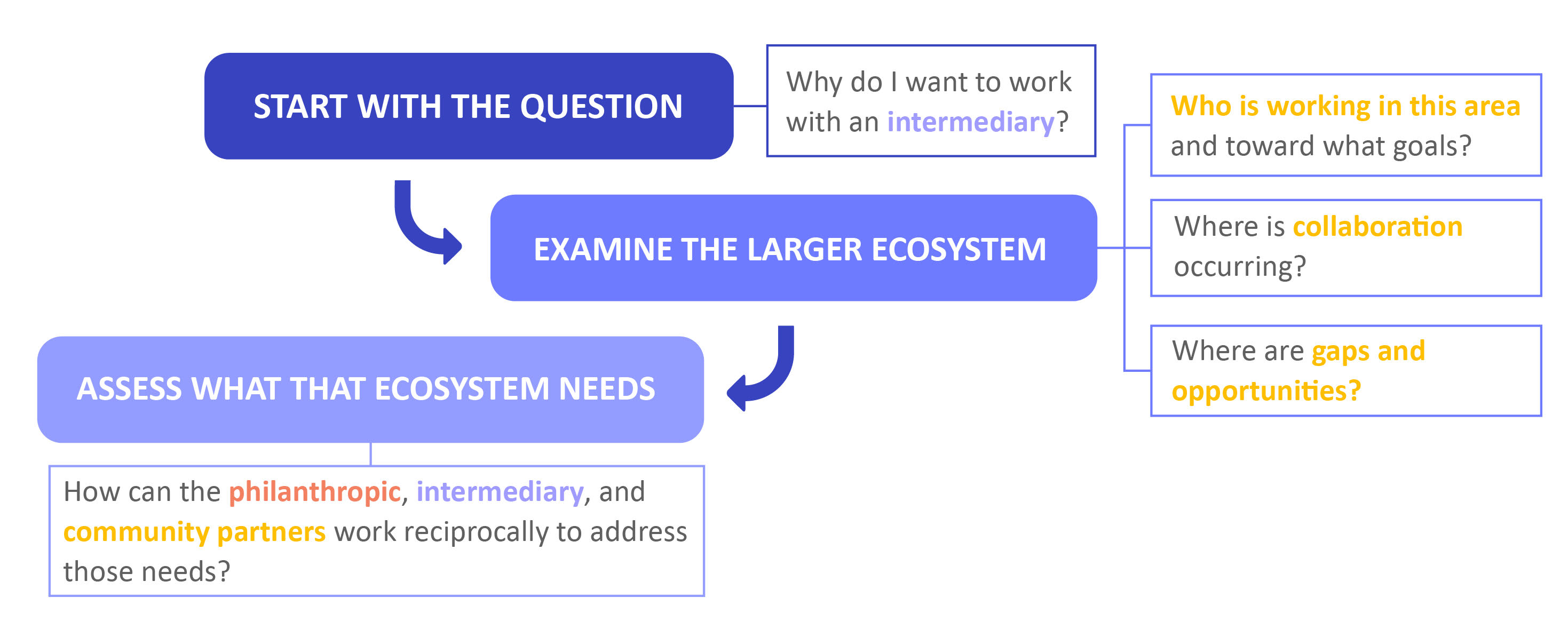Foundations have used intermediaries for a long time. “Used” is the operative word, however.
The relationship between foundations and intermediaries (like fiscal sponsors) tends to be transactional. Historically, foundations have looked at intermediaries as entities that help meet their needs.
In the past few years – in light of a heightened focus on racial equity and community voice– an increasing number of foundations are using intermediaries to connect with BIPOC-led, community-based, and other “hard-to-reach” organizations.
Those intermediaries have helped funders with everything from regranting, to program design and management, to fiscal hosting–all of which serve as a bridge between the foundation and prospective or existing grantees.
All of these functions are important. But because they’re still commissioned by funders, to serve funders, the power differentials that have long existed between foundations and those seeking funding remain.
In their rush to get funds out the door through intermediaries, funders tend to be focused more on where they’re going rather than how to get there. And this relationship can actually reinforce existing power dynamics instead of shifting them.
That’s one of the findings from a study we conducted for the Robert Wood Johnson Foundation. The study included more than 30 interviews with intermediaries, nonprofits and funders working with BIPOC-led, community-based, and small nonprofits.
What we found is that intermediaries don’t always see themselves, the work they do, and the problems they are asked to address the same way in which funders may see them.
Beyond the “shopping list”
In our conversations with intermediaries and grantees, we heard several critiques of assumptions that funders who want to reach community-based and BIPOC-led organizations have about using intermediaries to help meet that goal.
There was pushback to several commonly-accepted truisms in institutional philanthropy: that smaller organizations are always best positioned to drive community change; that intermediaries are effective in mitigating power imbalances; and that intermediaries can provide funders with “learning opportunities” from people “on the ground.”
According to intermediaries and grantees, one of the most repeated assumptions funders make is assuming they can just make a “shopping list” of potential intermediaries and pick and choose from this when trying to reach community-based or BIPOC-led groups.
One of the most repeated assumptions funders make is assuming they can just make a “shopping list” of potential intermediaries.
This “shopping list” approach is flawed in several ways. First, there is no clear definition of “intermediary.” In fact, almost every organization has the potential to be an intermediary, depending on what it’s doing, for whom, and under what circumstances; and there are a vast number and variety of organizations that can and do serve as intermediaries.
More importantly, this approach jumps over an important part of the process: taking a step back to clarify the functions for which an intermediary is needed before moving on to identify organizations that could provide those services.
As one interviewee–a senior vice president of a large foundation who supervises several program officers – noted: “It’s frustrating when program officers say things like “Here's what I want to do. Do you think I need an intermediary and if so, which one should I use?”
Instead, they argued, program officers should ask: “What am I trying to do in the field? What groups need to be supported in that field and do they even exist? And would intermediaries be helpful in responding to their needs? Which ones?’”
In other words, form should follow function.
If funders want to expand their reach to BIPOC-led and community-based organizations, they need to expand their perspective and be more intentional in the way they view and work with intermediaries.
That means taking a more holistic view of not only what funders need but also of what the organizations, networks, movements, and fields they are supporting need to achieve their goals. Essentially, the intermediary becomes a means to a greater end rather than an end unto itself.
Bottom line: the most important question for funders to ask is: Why do we want to use an intermediary, to what end, and how can we do that in a way that benefits all parties–the intermediary, grantee, and funder?
A new approach: Reciprocity, not Receivership
The question above reflects a growing desire for more reciprocity among philanthropic, intermediary, and community partners.
In contrast to the traditional transactional approach foundations have taken with intermediaries and their grantees, this perspective sees each partner as having assets and resources as well as needs, and affirms that naming and exploring these reciprocal relationships will lead to better structures and outcomes for our common mission-focused work.
The graphic below was developed with input from the Equitable Intermediary Project, a national cohort of intermediary leaders and funders working toward more equitable intermediary practices. It demonstrates this approach.

In summary, program officers who want to work with intermediaries to reach BIPOC, community-based, and other equity-focused organizations should think carefully about their motivations, strategies, and willingness to disrupt traditional approaches.
Most importantly, they need to consult and rely on the wisdom of the people who have first-hand knowledge about and experience with intermediaries and their many nuances, benefits, and challenges before making decisions about working with them.
Doing so not only helps funders but also the BIPOC and community-based groups they want to support and the intermediaries that are helping them—the kind of reciprocity that’s needed to achieve shared goals.
How funders can start
Where to begin? That’s the question we kept hearing from funders who wanted to work more equitably with intermediaries – but weren’t sure how to begin. In response, we developed this simple flow chart, in partnership with leaders from the Equitable Intermediary Project.
It offers a starting point for shifting from a transactional mindset to a reciprocal one. Rather than jumping to name an intermediary, the flow encourages funders to begin by asking the right questions, examining the broader ecosystem, and assessing what’s actually needed – by everyone involved.


%20(1280%20x%20720%20px)%20(10).webp)


